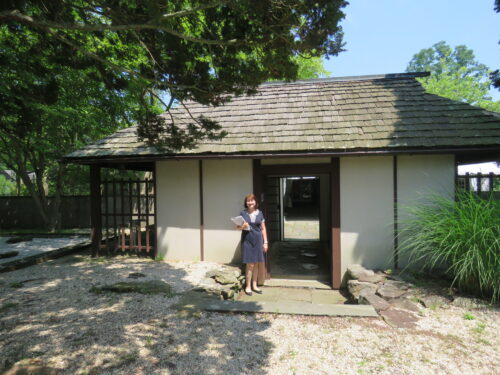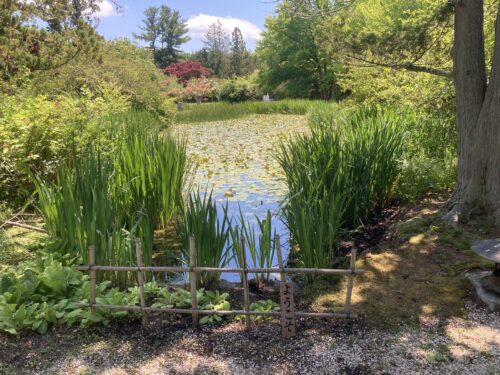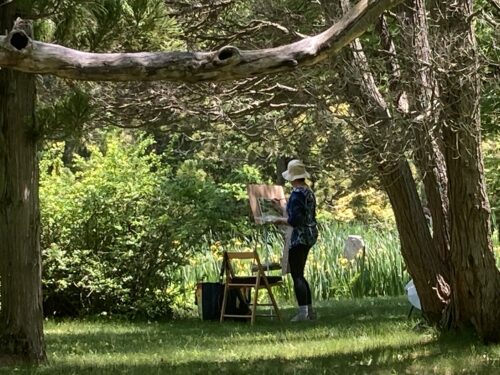I already anticipated tranquility and beauty before visiting the Hammond Museum and Japanese Stroll Garden in North Salem, so I was not surprised to experience just that–a welcome reminder that this Westchester County gem offers a grand opportunity to ‘just breathe’ after this challenging stretch of time.
That alone would be ‘enough.’ But as a pleasant surprise, it turned out to be delightfully more than that, too. It offered an opportunity to celebrate women, via showcasing deeply thoughtful, mega-talented women artists, their heartfelt works inside the newly reopened museum, or elegantly presented as sculpture throughout its plush and stunning gardens. That aspect of a Hammond experience may well have been in the spirit that its passionate founder, Natalie Hays Hammond, envisioned for visitors, too.

PHOTO by Grace Bennett
“Natalie was a woman ahead of her time…” began Elizabeth Hammer, Executive Director of Hammond, at the start of a toasty July tour of this sprawling 7-acre gem which sits gracefully atop rolling hills, a bucolic and elegant neighbor to the horse farms of North Salem–described to the public as a “fabled center of innovative art and Asian culture”–a truth immediately made evident on a tour which took place three months following the Museum’s celebrated reopening following a painful 17 months of Covid-induced closure.
At the outset, I learned that the Hammond family name comes with considerable accomplishment. Natalie Hammond was born in Lakewood, New Jersey, in 1904. Never married and childless, she started the museum on her own in 1957, as an heiress to her father John Hays Hammond, a mine engineer who together with Cecil Rhodes developed the diamond mines in South Africa. Her brother John Jay Hammond Jr., who was married (but also childless) was an inventor who founded the Hammond Castle in Gloucester, MA. Hammer relayed that Natalie’s activity and interest in the arts was boundless and varied–from a passion for the symbolic patterns of needlepoint (she authored a book on the anthology of pattern) to helping establish a woman’s production group with the Martha Graham Dance Company. The seeds to a life mission–to foster an East/West cultural understanding–began with travel to Japan in the 1920s; the culmination of her learning and efforts may have been with the opening of the Japanese Garden in 1961.

So, mission accomplished by Natalie who also recognized the special challenges women faced; Hammond’s rotating exhibits perhaps reflect what the board and staff have gathered was understood to be an unyielding support for women. A current Broad Powers exhibit celebrates the 100th anniversary of the women’s suffragette movement; in it, three artists collaborated to share their whimsical visions, and challenge visitors. Marcy Freedman, also an art historian, for example, takes landmark paintings of women and transposes them into contemporary clothes and occupations. “It gives you a window to learn about someone through their activity,” explained Hammer. Carla Rae Johnson, a second artist, asks you “to envision yourself as a Virginia Woolf or Harriet Tubman but in her mind in a contemporary progressive setting of going to clean the river or help children at the border.”
One of the three collaborators of Broad Power, Mary McFerran examines the sacrifices and contradictions experienced by the Suffragists as they struggled to achieve women’s right to vote.
Mary McFerran brings to life the contradictory messages women grappled with as they fought vigorously for their freedom. “Fashion was not so free; women were still wearing corsets,” noted Hammer. “Today’s stilettos?” The artist challenges you “to not forget what women put up with–harassment, divorce, and ostracism–all for agitating for the right to vote.” 
Meanwhile, in the exhibit called Voices: I Remember, each of the six women artists ‘voices’ rings loud through their works. Jill Parry painted images of her mother while the artist kept vigil over her final days. At the other end of life, Eleni Smolen, inspired by a photograph of herself when she was young, painted the Girl by the Sea and Guardians Series as an exploration of memory and the ambiguity of nostalgia.
While the museum exhibits challenge you to think, the stroll will reward you with a chance to simply relax and enjoy Hammond’s glorious nod to nature, and indeed to capture the Zen of humanity’s fresh start today… as you admire Japanese cypress, “a grove of maple trees that turn really bright red and orange in the autumn,” a dense stand of bamboo and ‘smoke bushes’ which dot a ‘mature’ 60-year-old garden. Take your time, too, contemplating each of the artists’ sculptures under the open skies; at least a half dozen, along with traditional Japanese statuary, are interspersed on Hammond property throughout the stroll garden. For a dash of something fun, consider the giant stone chess ‘board’ on one lawn, with its oversized pieces for a family match.

FALL PROGRAMMING
The museum and stroll garden are open April through November, Wednesday through Saturday, noon to 4 p.m. Come with your family and friends…and bring a picnic lunch and a blanket and enjoy the tranquility and beauty of your surroundings.
A complete schedule of coming events and lectures, including the museum’s popular Moon Viewing Festival on September 11th and a symposium about the garden on September 24th, as well as information about memberships, member benefits and the opportunity to arrange for an individual, family or group tour of the gallery and stroll garden, can be found on the Hammond website: www.HammondMuseum.org. To schedule a docent-led tour with tea and Japanese sweets, call (914) 669-5033; for special pop-up events and extended hours, visit the website.
The Hammond can also be booked for special family occasions such as weddings, bar- and bat-mitzvahs and family reunions as well as corporate events with a flair and surrounded by the serenity of nature.

